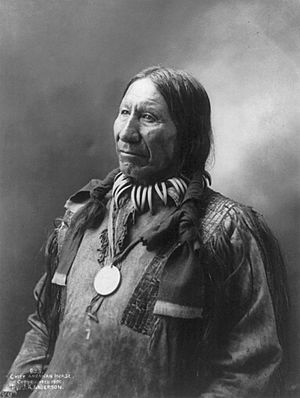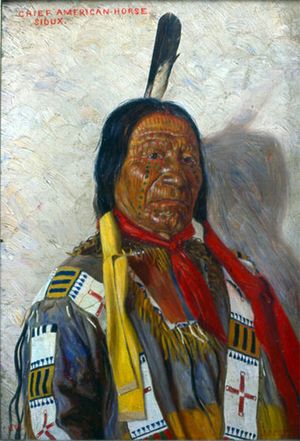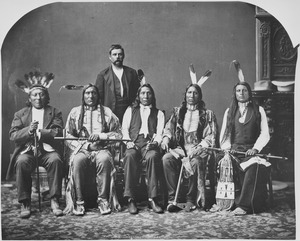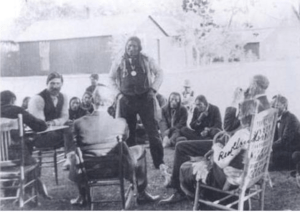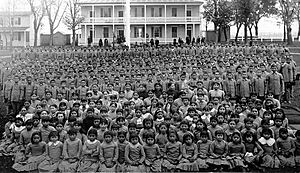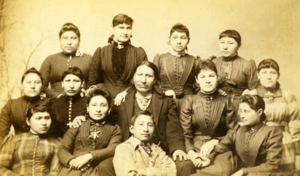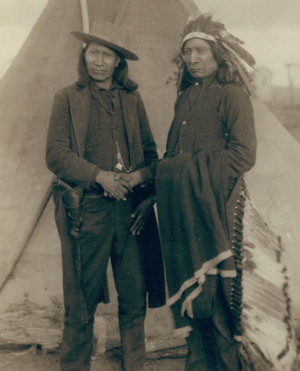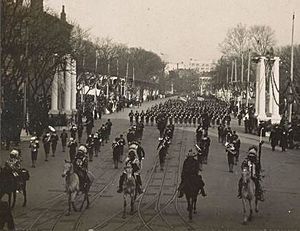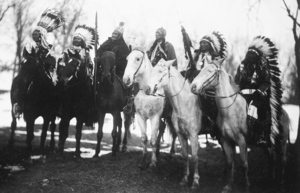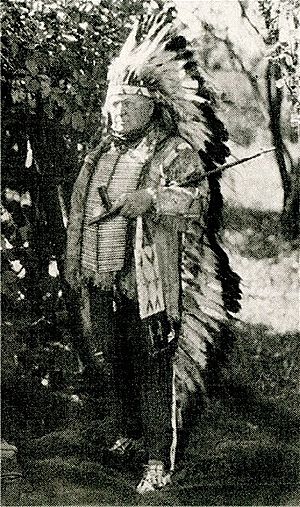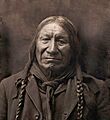American Horse facts for kids
Quick facts for kids
American Horse
|
|
|---|---|
| Wašíčuŋ Tȟašúŋke (He-Has-A-White-Man's-Horse) | |
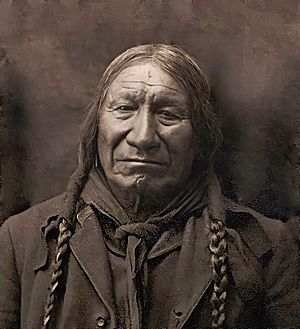
American Horse ca 1905.
|
|
| Oglala Lakota leader | |
| Personal details | |
| Born | 1840 Black Hills, South Dakota, U.S. |
| Died | December 16, 1908 (aged 67–68) Pine Ridge, South Dakota, U.S. |
| Resting place | Holy Cross Cemetery, Pine Ridge |
| Relations | Son-in-law of Red Cloud |
| Children | Ben American Horse, Samuel American Horse, Thomas American Horse, Charles American Horse, Bear Don't Scare Guy, Maggie Stands Looking |
| Parents | Father, Sitting Bear. Mother, Walks With. |
| Nickname | Spider |
American Horse (Lakota: Wašíčuŋ Tȟašúŋke), also known as "American Horse the Younger," was an important Oglala Lakota chief. He lived from 1840 to December 16, 1908. He was a leader, a teacher, and a historian for his people.
American Horse was known for working well with white settlers. He also believed in education for his people. He served as a scout for the U.S. Army. He disagreed with Crazy Horse during the Great Sioux War of 1876-1877. He also opposed the Ghost Dance Movement in 1890. American Horse traveled to Washington D.C. as a Lakota representative. He was one of the first Native Americans to join Buffalo Bill's Wild West show. He also supported the Carlisle Indian Industrial School. He was known for his strong leadership and wise words.
Contents
- Early Life and Adventures
- U.S. Army Indian Scout
- Taking the Name American Horse
- The Death of Crazy Horse
- The Wagluhe People
- Peace Talks in Washington
- Performing in the Wild West Show
- Carlisle Indian Industrial School
- Opposing the Ghost Dancers
- Theodore Roosevelt's Inaugural Parade 1905
- Major Israel McCreight
- American Horse's Winter Count
- Final Years
- Images for kids
- See also
Early Life and Adventures
American Horse was first called Manishnee, meaning "Cannot Walk." His nickname was Spider. When he was born, his grandfather wished for him to have the "warm blood of a warrior." His father, Sitting-Bear, was a leader of the True Oglalas. Sitting-Bear died in battle when American Horse was very young. An uncle then raised him. As a young man, American Horse joined war parties against the Crow and Shoshone tribes.
When he was about ten, three Crow warriors attacked him. He was driving ponies to water. He quickly hid in some willow bushes. He yelled to make the ponies run home. Some ponies were caught, but American Horse was safe. When asked how he escaped, he said, "I knew they would not hunt for small game when there was so much bigger close by."
Another time, a group of Shoshones was found nearby. As everyone got ready to attack, young American Horse saw a fat deer. He shot it with an arrow. He and his hungry friends quickly ate some of the deer's liver. Then they rushed to fight their enemies. People still tell stories of how American Horse hunted and ate between an ambush and an attack.
U.S. Army Indian Scout
In the early 1870s, American Horse moved to the Red Cloud Agency. He became close with the Wagluhe people at Fort Robinson. He also became the son-in-law of Chief Red Cloud. American Horse soon joined as a U.S. Army Indian Scout. The military often used him to keep young warriors calm. He also helped recruit new scouts.
An Incident with Sioux Jim
On August 31, 1876, American Horse was involved in the death of Sioux Jim. This happened about a month after the Battle of the Little Bighorn. Colonel Ranald S. Mackenzie wanted Sioux Jim arrested. American Horse tried to arrest Sioux Jim in the village. During this attempt, Sioux Jim was shot and killed. This event was reported by Colonel Mackenzie.
Taking the Name American Horse
There were two important Oglala Lakota chiefs named American Horse. To tell them apart, historians call them "American Horse the Elder" and "American Horse the Younger."
Chief American Horse the Elder (1830-1876) was a brave warrior. He was a leader during Red Cloud's War and the Battle of the Little Bighorn. He was a son of Old Chief Smoke, a respected Oglala Lakota chief. American Horse the Elder signed the Fort Laramie Treaty of 1868. He was badly wounded in the Battle of Slim Buttes on September 9, 1876. He was fighting to protect his family and the Black Hills.
American Horse the Younger became more important after the Great Sioux War of 1876–1877. After hearing about the death of American Horse the Elder, Manishnee (American Horse the Younger's first name) took on the name "American Horse." He was not related to American Horse the Elder. He was the son of Sitting Bear. Some historical accounts have mixed up the stories of the two chiefs. There are no known photos or drawings of American Horse the Elder.
The Death of Crazy Horse

On May 6, 1877, Crazy Horse surrendered at Fort Robinson. For the next four months, he lived in his village. American Horse and other Oglala leaders worried about Crazy Horse. They felt he might cause more trouble with the white settlers. They wanted to "quiet" Crazy Horse and make him feel better about the peace talks. But Crazy Horse refused to meet them.
Rumors spread that Crazy Horse wanted to return to his old way of life. General Crook came to Fort Robinson. He hoped to talk to Crazy Horse. But he was warned that Crazy Horse might try to harm him. General Crook returned to camp and asked the chiefs to meet him there. Crazy Horse did not come. The chiefs told General Crook they did not approve of Crazy Horse's actions. They were ready to follow the general. Crook asked them to arrest Crazy Horse. American Horse, Red Cloud, Little Wound, and Young Man Afraid of His Horse agreed to help the soldiers arrest Crazy Horse.
On September 4, 1877, soldiers and friendly Native Americans went to Crazy Horse's village. But the village had scattered. Crazy Horse went to the Spotted Tail Agency with his sick wife. There, agency Native Americans arrested him. On September 5, 1877, Crazy Horse was taken to Fort Robinson. He struggled with a guard and tried to escape. He was stabbed with a bayonet and died later that night.
The Wagluhe People
The Wagluhe Band is one of the seven groups of the Oglala Lakota. They were also called the Loafer Band. Old Chief Smoke was an important Oglala Lakota chief. He understood the power of the white settlers. In 1849, he moved his Wagluhe camp to Ft. Laramie, Wyoming. The U.S. Army was there to protect settlers on the Oregon Trail. Other Lakota families joined Smoke's camp for safety.
The Wagluhe knew that fighting the white settlers was not a good idea. They had heard about the huge battles of the Civil War, like the Battle at Gettysburg. They learned the customs of the white people. The U.S. Army and Indian agents saw the Wagluhe as a progressive group. Many Wagluhe became Indian Police or U.S. Army Indian Scouts. They helped communicate with other Lakota groups. The Wagluhe were also the first Oglala Lakota to send their children to the Carlisle Indian Industrial School. They were also the first to join Col. "Buffalo Bill" Cody's Wild West show.
After the Battle of the Little Bighorn, American Horse became a leader. He spoke for the group that wanted to work with the government. He was very active in supporting reform programs. The Wagluhe split into three bands. Blue Horse led one, and American Horse and Three Bears led the other two. Red Shirt was also a popular leader. These leaders had much in common. They all served as U.S. Army Indian Scouts. They sent their children to the Carlisle Indian Industrial School. They led Lakota groups to Washington, D.C. And they all performed in Buffalo Bill's Wild West show.
Peace Talks in Washington
Chief American Horse went to many peace conferences in Washington. From 1865 to 1877, he believed it was best to work with the government. He felt that resistance was useless. This helped calm his people. After Crazy Horse's death, American Horse continued to work with the government.
He was known for his powerful speeches. He often spoke about peace. But he could also speak sharply about the unfairness of the white people. He was a master of quick, clever replies. He once said that if you needed "golden slippers" to enter the white man's heaven, no Native American would get there. This was because the white people had taken the Black Hills, which had all the gold. His leadership was always strong and consistent.
Performing in the Wild West Show
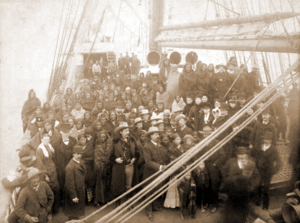
Joining "Wild Westing" shows was very popular for the Lakota people. It helped their families and communities. It offered new chances during a time when many thought Native Americans would disappear. Between 1887 and World War I, over 1,000 Native Americans performed in Buffalo Bill's Wild West. Most were Oglala Lakota from Pine Ridge, South Dakota. Buffalo Bill Cody used his influence to get Native American performers for his show.
In 1886, American Horse became the main Native American performer. A reporter asked him what he thought of the East. He said, "I see so much that is wonderful and strange that I feel a wish to go out in the forest and cover my head with a blanket, so that I can see no more and have a chance to think over what I have seen." On March 31, 1887, Chief American Horse, Chief Blue Horse, and Chief Red Shirt traveled to England. They were part of Buffalo Bill's first international tour. They performed for Queen Victoria's Golden Jubilee. The group included 97 Native Americans, 18 buffaloes, and many other animals and horses.
Buffalo Bill treated his Native American performers fairly. They received good pay, travel, housing, and food. They also got gifts of clothes and money. They worked as performers, interpreters, and recruiters. Men earned money for their families on the reservation. Women were paid extra for their children. They also made and sold Lakota crafts. Older Native American men helped ensure young men behaved well. These performers were called "Show Indians" or "Oskate Wicasa," a title of great honor. Wild Westing became a family tradition for many Pine Ridge families. American Horse's sons, Ben and Samuel, also performed and worked as interpreters.
Carlisle Indian Industrial School
School History
The Carlisle Indian Industrial School in Carlisle, Pennsylvania, was a famous boarding school for Native American children. It operated from 1879 to 1918. It was the first school of its kind located far from reservations. The school aimed to "Kill the Indian, save the man." This meant they tried to make Native American children act and behave like white people. Children were often taken from their families. They were taught to speak English and learn trade skills. They were not allowed to express their Native culture.
For some, attending Carlisle was a chance for a better future. It produced a new generation of Native American leaders. For others, it caused a loss of culture and family ties.
American Horse and Captain Pratt
American Horse was one of the first to support education for Native Americans. His son Samuel and nephew Robert were among the first students at Carlisle. Captain Richard Henry Pratt, the school's founder, visited Pine Ridge. He faced opposition from Red Cloud, who did not trust white education. But American Horse was very interested in what Pratt had to say.
American Horse was an important leader. He had a large family with two wives and at least ten children. He was skilled at dealing with both Lakota traditions and the new white society. He was a smart politician. His friendly approach with white people was a way to gain benefits for his people. He believed his children would have to deal with white people in the future. American Horse agreed to send two sons and a daughter to the first class: Ben American Horse, Samuel American Horse, and Maggie Stands Looking. Charles A. Eastman said, "His daughters were the handsomest Indian girls of full blood that I ever saw."
Maggie Stands Looking's Story
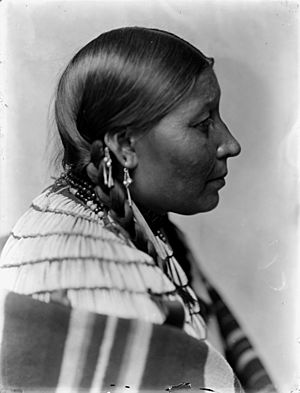
Maggie Stands Looking was one of Captain Pratt's best students. She wrote a letter to her father in 1881. She said she was glad her brother was married. She also said she and her cousins were well at the school. She was happy there but worried about her grandfather. She hoped to learn to write so she could write more often. She was glad her father had a "white man's house" and many animals. She wanted to learn all she could to live with him later.
Maggie had some trouble adjusting to school rules. Once, she slapped a matron who insisted she make her bed. But Maggie eventually followed the rules. Like many students, Maggie joined the "Outing Program." This program placed students with non-Native families during the summer. This was meant to continue their learning of white customs. Maggie once wrote to Captain Pratt from her country home. She asked what to do because her host family had no bath. Pratt advised her to use a wash basin, just as he did.
Carlisle Wild Westers
Many Oglala Lakota from Pine Ridge Reservation who performed in Wild West shows also attended Carlisle. They were drawn by the adventure, pay, and opportunities. They worked as performers, chaperones, interpreters, and recruiters. Oglala Lakota leaders like Chief Blue Horse, Chief American Horse, and Chief Red Shirt sent their children to Carlisle from its start in 1879. They wanted their children to learn English, trade skills, and white customs. Luther Standing Bear left the reservation to attend Carlisle. He wanted to do something brave to honor his family. His father celebrated his son's brave act by giving away horses and goods.
Opposing the Ghost Dancers
During the "Messiah craze" or Ghost Dance movement in 1890-1891, American Horse showed his true strength. While many of his friends joined the new movement, he stayed away. He told his band to do the same. When the movement grew, he took a strong stand against it. All Native Americans who did not dance the Ghost Dance were told to come to the Pine Ridge Agency. American Horse was the first to bring his people in.
During a tense moment, a man named Little was arrested. Some people wanted him to resist, hoping it would start a fight. This could lead to a massacre. American Horse strongly opposed this plan. On a day when thousands of Native Americans were at the agency, Little walked among them. The police arrested him. A crowd rushed to help him. There was confusion and shouts to "Kill them all!"
American Horse walked out of the agent's office. He calmly faced the angry crowd. "What are you going to do?" he asked. "Stop, men, stop and think before you act! Will you murder your children, your women, yes, destroy your nation today?" He stood firm. He continued, "You are brave today because you outnumber the white men. But what will you do tomorrow? Soldiers will come from every direction. You have little food or ammunition. It will be the end of your people. Stop, I say, stop now!" Jack Red Cloud, the old chief's son, pointed a gun at American Horse. He shouted that American Horse had made their people slaves. But American Horse did not flinch. He went back into the office. His timely words and bravery saved the day. Other police and friendly Native Americans took control. American Horse later said the agent and clerks had fled to the cellar. He believed his actions had prevented a disaster.
Theodore Roosevelt's Inaugural Parade 1905
On March 4, 1905, Wild West performers and Carlisle students appeared in Theodore Roosevelt's first Inaugural Parade. Six famous Native American Chiefs were there: Geronimo, Quanah Parker, Buckskin Charlie, American Horse, Hollow Horn Bear, and Little Plume. They practiced in Carlisle, Pennsylvania, with the Carlisle Cadets and Band. President Roosevelt watched the parade. When the Native American chiefs rode by, he waved his hat. Everyone in the President's box stood up. The chiefs wore face paint and feather headdresses. They were followed by the Carlisle Indian School Band and 350 cadets. Geronimo led the group. It was reported that "The Chiefs created a sensation." People focused on the chiefs, and the cadets received less attention.
Major Israel McCreight

Chief American Horse was always a welcome guest at The Wigwam. This was the home of Major Israel McCreight in DuBois, Pennsylvania. The Wigwam was a place for politicians, businessmen, and adventurers to relax. It was also a second home for Oglala Lakota "Oskate Wicasa" (Show Men). Wild West performers found The Wigwam a warm place to rest. They could sleep in buffalo skins, walk in the woods, and share their stories. Once, 150 Native Americans from Buffalo Bill's Wild West camped there. Many chiefs visited The Wigwam, including American Horse, Blue Horse, and Iron Tail.
On June 22, 1908, McCreight was made an honorary Chief of the Oglala Lakota. He was named "Cante Tanke" ("Great Heart"). On that day, Col. William "Buffalo Bill" Cody was in Du Bois, Pennsylvania, with his Wild West show. Twelve thousand people attended his performances daily. The ceremony for McCreight was performed by Chief Iron Tail. Chief American Horse and other Oglala Lakota Wild Westers were present.
American Horse's Winter Count
Chief American Horse was a Lakota historian. He created a "winter count" on a piece of cloth. It recorded over one hundred years of Lakota history, from 1775 to 1878. Lakota years are named after an important event that happened during that winter. For example, the year 1866 was called "They killed one hundred white men" (referring to the Fetterman Incident). The year 1876 was "They took horses from Red Cloud." The year 1877 was "When they killed Crazy Horse." And 1890 was "When they killed Big Foot" (the Wounded Knee Massacre).
In 1879, American Horse drew his winter count in a sketchbook for an Army surgeon, William H. Corbusier. Corbusier sent it to the Smithsonian. American Horse said the winter count had been passed down in his family for generations. It went from his grandfather, to his father, and then to him. American Horse was born in the year they stole many horses from the Flatheads, which was 1840–41. His death is noted in another calendar for the year 1908–09.
Final Years
Chief American Horse passed away peacefully in his home near Kyle, Pine Ridge, South Dakota. He died on December 16, 1908.
Images for kids
See also
 In Spanish: Caballo americano para niños
In Spanish: Caballo americano para niños


